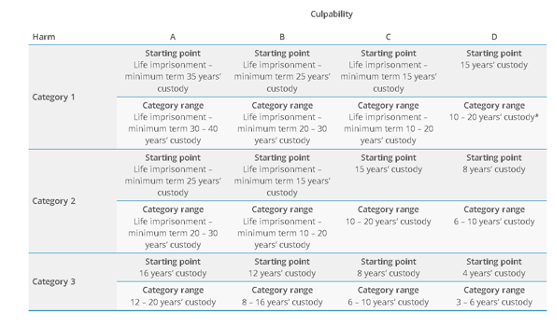Terrorism Sentencing Guidelines
1. Acts preparatory to Terrorism
Under section 5 of the Terrorism Act 2006, a person may be charged with ‘preparation of a terrorist act’. In order to commit this offence a person must have the intention of committing an act of terrorism or have the intention of assisting another to commit an act of terrorism (engages in any conduct in preparation for giving effect to his intention).
Acts which may be considered as an act of terrorism include, but are not limited to:
- Firearms offences (possession, manufacturing, selling etc)
- Being in possession of a bomb or bomb making equipment
- Training or instructing others for acts of terrorism
Section 5 Terrorism Act 2006 covers preparation at a very early stage, including internet research.
It is also irrelevant to section 5 whether the intention of preparations relate to one of more specific acts of terrorism, act of terrorism of a particular description of general acts of terrorism.
The person’s culpability is defined into one of following categories (A = highest, D = lowest):
Category A
- Acting alone, or in a leading role, in terrorist activity where preparations were complete or were so close to completion that, but for apprehension, the activity was very likely to have been carried out.
Category B
- Acting alone, or in a leading role, in terrorist activity where preparations were advanced and, but for apprehension, the activity was likely to have been carried out
- Significant role in terrorist activity where preparations were complete or were so close to completion that, but for apprehension, the activity was very likely to have been carried out
- Offender has coordinated others to take part in terrorist activity, whether in the UK or abroad (where not falling within A)
Category C
- Leading role in terrorist activity where preparations were not far advanced
- Significant role in terrorist activity where preparations were advanced and, but for apprehension, the activity was likely to have been carried out
- Lesser role in terrorist activity where preparations were complete or were so close to completion that, but for apprehension, the activity was very likely to have been carried out
- Offender acquires training or skills for purpose of terrorist activity (where not falling within A or B)
- Acts of significant assistance or encouragement of other(s) (where not falling within A or B)
Category D
- Offender has engaged in very limited preparation for terrorist activity
- Act(s) of lesser assistance or encouragement of other(s)
- Other cases not falling within A, B or C
The person’s harm caused is defined into one of following categories (1= highest, 3 = lowest):
Category 1
- Multiple deaths risked and very likely to be caused
Category 2
- Multiple deaths risked but not very likely to be caused
- Any death risked and very likely to be caused
Category 3
- Any death risked but not very likely to be caused
- Risk of widespread or serious damage to property or economic interests
- Risk of a substantial impact upon civic infrastructure
- Any other cases
If found guilty of the offence of preparation of a terrorist act, a person will be tried on indictment and could receive a sentence of between 3 years to life imprisonment depending on the determination of their culpability and harm.
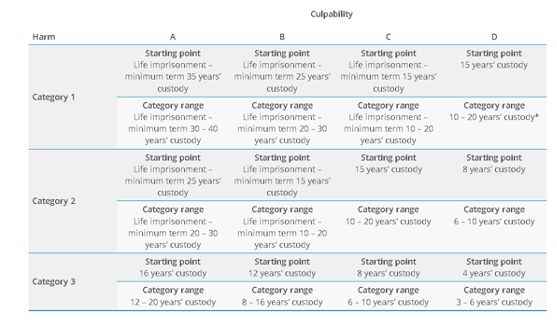
Encouragement of Terrorism
Under section 1 of the Terrorism Act 2006, a person may be charged with ‘encouragement of terrorism’ if they:
- Publish a statement which causes another person to publish such a statement; and
- At the time they publish it they:
- Intend members of the public to be directly or indirectly encouraged or otherwise induced by the statement to commit, prepare or instigate acts of terrorism; or
- Were reckless as to whether members of the public would be directly or indirectly encouraged or otherwise induced by the statement to commit, prepare or instigate acts of terrorism.
It does not matter whether in fact any person was encouraged or induced to commit, prepare or instigate acts of terrorism.
The person’s culpability is defined into one of following categories (A = highest, C= lowest):
Category A
- Offender in position of trust, authority or influence and abuses their position to encourage others
- Intended to encourage others to engage in any form of terrorist activity
- Intended to provide assistance to others to engage in terrorist activity
Category B
- Reckless as to whether others would be encouraged or assisted to engage in terrorist activity and published statement/disseminated publication widely to a large or targeted audience (if via social media this can include both open or closed groups)
Category C
- Other cases where characteristics for categories A or B are not present
The person’s harm caused is defined into one of following categories (1= highest, 3 = lowest):
Category 1
- Evidence that others have acted on or been assisted by the encouragement to carry out activities endangering life
- Statement or publication provides instruction for specific terrorist activity endangering life
Category 2
- Evidence that others have acted on or been assisted by the encouragement to carry out activities not endangering life
- Statement or publication provides non-specific content encouraging support for terrorist activity endangering life
- Statement or publication provides instruction for specific terrorist activity not endangering life
Category 3
- Statement or publication provides non-specific content encouraging support for terrorist activity not endangering life
- Other cases where characteristics for categories 1 or 2 are not present
Encouraging terrorism is a triable either way offence and if found guilty a person could receive a sentence ranging between a high-level community order and 15 years imprisonment depending on the determination of their culpability and harm.
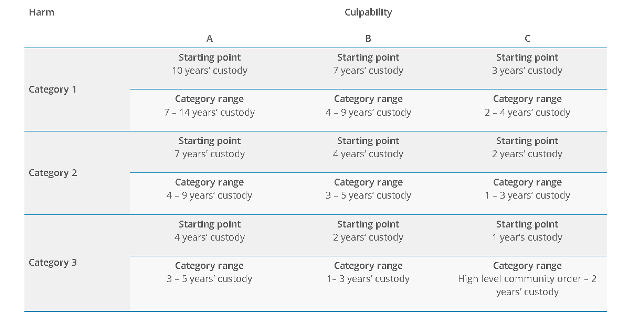
3. Dissemination of terrorist publications
Under section 2 of the Terrorism Act 2006, a person may be charged with ‘dissemination of terrorist publications’ if they:
- Distribute or circulate a terrorist publication;
- Gives, sells or lends a terrorist publication;
- Offers as terrorist publication for sale or loan;
- Provides a service to others which enables another to obtain, read, listen or look at terrorist publications or acquire them by means of a gift, sale or loan;
- Transmit the content of terrorist publications electronically; or
- Has a terrorist publication in their possession with a view to becoming the subject of any of the above.
A person must also either intend or be reckless to the effect of their conduct being a direct or indirect encouragement or other inducement to the commission, preparation or instigation of acts of terrorism or that their conduct be provision or assistance in the commission of acts of terrorism.
The person’s culpability is defined into one of following categories (A = highest, C= lowest):
Category A
- Offender in position of trust, authority or influence and abuses their position to encourage others
- Intended to encourage others to engage in any form of terrorist activity
- Intended to provide assistance to others to engage in terrorist activity
Category B
- Reckless as to whether others would be encouraged or assisted to engage in terrorist activity and published statement/disseminated publication widely to a large or targeted audience (if via social media this can include both open or closed groups)
Category C
Other cases where characteristics for categories A or B are not present
The person’s harm caused is defined into one of following categories (1= highest, 3 = lowest):
Category 1
- Evidence that others have acted on or been assisted by the encouragement to carry out activities endangering life
- Statement or publication provides instruction for specific terrorist activity endangering life
Category 2
- Evidence that others have acted on or been assisted by the encouragement to carry out activities not endangering life
- Statement or publication provides non-specific content encouraging support for terrorist activity endangering life
- Statement or publication provides instruction for specific terrorist activity not endangering life
Category 3
- Statement or publication provides non-specific content encouraging support for terrorist activity not endangering life
- Other cases where characteristics for categories 1 or 2 are not present
Dissemination of terrorist publications is a triable either way offence and if found guilty a person could receive a sentence ranging between a high-level community order and 15 years imprisonment depending on the determination of their culpability and harm.
4. Training for Terrorism
Under section 6 of the Terrorism Act 2006, a person may be charged with ‘training for terrorism’ if they provide instruction or training in any skills that could be used to commit terrorism, and at the time of training or instruction the person knew that his instructions or training would be used by the other person for the commission or terrorist acts or assisting in them.
Skills which could be used to commit terrorist acts include:
- Making, handling or use of a noxious substance;
- Making or using firearms, radioactive material or weapons designed or adapted for the discharge of any radioactive material or explosives
- Making of using chemical, biological or nuclear weapons
- The use of any method or technique for doing anything else that is capable of being done for the purpose of terrorism; or
- Design or adaptation for the purpose of terrorism.
It is irrelevant how many people the instruction or training was provided to or whether the training or instructions refers to one or more acts which constitute terrorism.
5. Funding Terrorism
Under section 15 of the Terrorism Act 2000, a person may be charged with ‘fund-raising’ for terrorism if they invite, receives money or other property and has reasonable belief that this will be used for the purpose of terrorism.
Under section 16 of the Terrorism Act 2000, a person may be charged with ‘use and possession’ for they purpose of terrorism if they use money or property for the purpose of terrorism or if they possess money or property and intend for it to be used for the purpose of terrorism.
Under section 17 of the Terrorism Act 2000, a person may be charged with ‘funding arrangements’ of terrorism if they enter or become concerned in an arrangement whereby money or other property made available for the purposes of terrorism.
Under section 18 of the Terrorism Act 2000, a person may be charged with ‘money laundering’ if they enter or become concerned in an arrangement which facilitates the retention or control of terrorist property by concealment, removal from the jurisdiction, by transfer to nominees or in any other way.
The person’s culpability is defined into one of following categories (A = highest, C= lowest):
Category A
- A significant role where offending is part of a group activity
- Involvement of others through pressure or influence
- Abuse of position of power, trust or responsibility
- Sophisticated nature of offence/significant planning
- Activities took place over a sustained period of time
Category B
- Other cases that fall between categories A or C because:
- Factors are present in A and C which balance each other out and/ or
- The offender’s culpability falls between the factors as described in A and C
Category C
- Performed limited function under direction
- Very little or no planning
The person’s harm caused is defined into one of following categories (1= highest, 3 = lowest):
Category 1
- Money or property made, or was likely to make, a significant contribution to furthering terrorism
- Use or provision of money or property to fund or assist activities endangering life
Category 2
- Use or provision of money or property to fund or assist activities which involve a risk of widespread or serious damage to property, or economic interests or substantial impact upon civic infrastructure
- All other cases whose characteristics fall between 1 and 3
Category 3
- Money or property made, or was likely to make, a minor contribution to furthering terrorism
The above offences are categorised as funding terrorism which is a triable either way offence and if found guilty a person could receive a sentence which ranges from a high-level community order to 14 years imprisonment depending on the determination of their culpability and harm.
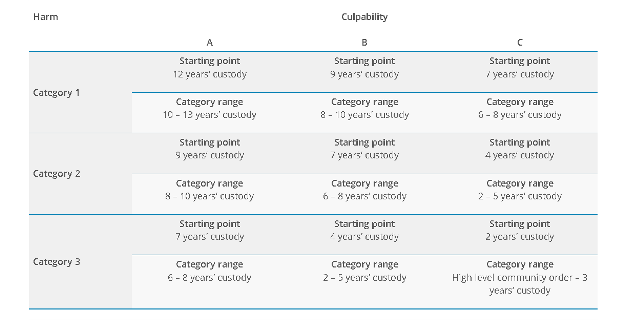
6. Possession for Terrorist Purposes
Under section 57 of the Terrorism Act 2000, a person may be charged with ‘possession for terrorist purposes’ if they possess an article which in the circumstances gives rise to reasonable suspicion that their possession is for a purpose which is connected to the commission, preparation or instigation of an act of terrorism.
The person’s culpability is defined into one of following categories (A = highest, C= lowest):
Category A
- Possession of article(s) indicates that offender’s preparations for terrorist activity are complete or almost complete
- Offender is a significant participant in the commission, preparation or instigation of an act of terrorism
Category B
- Cases falling between A and C
Category C
- Possession of article(s) indicates that offender has engaged in limited preparation toward terrorist activity
- Offender is of limited assistance or encouragement to others who are preparing for terrorist activity
The person’s harm caused is defined into one of following categories (1= highest, 3 = lowest):
Category 1
- Article(s) had potential to facilitate an offence endangering life and harm is very likely to be caused
Category 2
- Article(s) had potential to facilitate an offence endangering life but harm is not very likely to be caused
- Article(s) had potential to facilitate an offence causing widespread or serious damage to property, or economic interest or substantial impact upon civic infrastructure
Category 3
- All other cases
Possession for terrorist purposes is a triable either way offence and if found guilty a person could receive a sentence which ranges from a high-level community order to 15 years imprisonment depending on the determination of their culpability and harm.
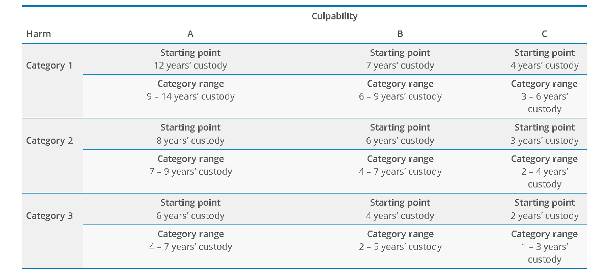
7. Failure to Disclose Information about Acts of Terrorism
Under section 38B of the Terrorism Act 2000, a person may be charged with ‘failure to disclose information about acts of terrorism’ if they have information which they know or believe might be of material assistance in preventing the commission of an act of terrorism or in securing the apprehension, prosecution or conviction of a person involved in the commission, preparation or instigation of an act of terrorism.
A person commits an offence if they do not disclose the information as soon as reasonably practicable.
The person’s culpability is defined into one of following categories (A = highest, C= lowest):
Category A
- Information was very significant (including, but not limited to, information which could have prevented an act of terrorism)
Category B
- Cases whose characteristics fall between A and C
Category C
- Information was of low significance
The person’s harm caused is defined into one of following categories (1= highest, 2 = lowest):
Category 1
- Information related to terrorist activity endangering life
- Information related to terrorist activity intended to cause widespread or serious damage to property, or economic interest or substantial impact upon civic infrastructure
Category 2
- All other cases
A possible defence to being charged with failure to disclose information about acts of terrorism is to prove that the person had reasonable excuse for not making the disclosure. This will often arise in situations where there are fears of reprisal or reaction going beyond the defence of duress.
Failure to disclose information about acts of terrorism is a triable either way offence and if found guilty a person could receive a sentence which ranges from a high-level community order to 10 years imprisonment depending on the determination of their culpability and harm.
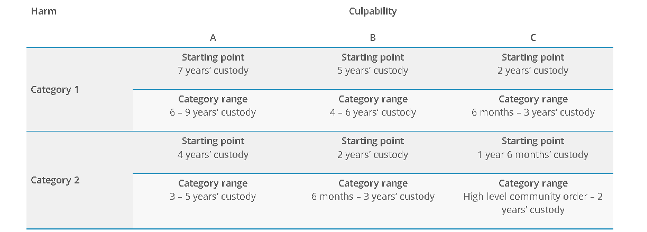
8. Being a Member of a Terrorist Organisation
Under section 11 of the Terrorism Act 2000, a person may be charged with ‘being a member of a terrorist organisation; if they belong or profess to belong to a proscribed organisation.
A proscribed organisation is an organisation that the Home Secretary believes commits or permits acts of terrorism, prepares for terrorism, promotes or encourages terrorism or is otherwise concerned in terrorism.
The person’s culpability is defined into one of following categories (A = highest, C= lowest):
Category A
- Prominent member of organisation
Category B
- Active (but not prominent) member of organisation
Category C
- All other cases
There is no variation in the level of harm that is caused. Membership of any organisation which is concerned in terrorism either through the commission, participation, preparation, promotion or encouragement of terrorism is inherently harmful.
Being a member of a terrorist organisation is a triable either way offence and if found guilty a person could receive a sentence which ranges from high level community order to 14 years imprisonment depending on the person’s culpability.

9. Support of a Terrorist Organisation
Under section 12 of the Terrorism Act 2000, a person may be charged with supporting a terrorist organisation if they:
- Invite support for a proscribed organisation and they support is not, or is not restricted to, the provision of money or other property (within the meaning of section 15); or
- Expresses and opinion or belief that is supportive of a proscribed organisation and in doing so is reckless as to whether a person to whom the expression is directed will be encouraged to support a proscribed organisation; or
- Arrange, manage or assist in arranging or managing a meeting which they know is to supported a proscribed organisation, t further activities of a proscribed organisation or to be addressed by a person who belongs or professes to belong to a proscribed organisation; or
- Address a meeting and the purpose of their address is to encourage support for a proscribed organisation or to further it’s activities.
The person’s culpability is defined into one of following categories (A = highest, C= lowest):
Category A
- Intentional offence – Offender in position of trust, authority or influence and abuses their position
- Persistent efforts to gain widespread or significant support for organisation
- Encourages activities intended to cause endangerment to life
Category B
- Reckless offence – Offender in position of trust, authority or influence and abuses their position
- Arranged or played a significant part in the arrangement of a meeting/event aimed at gaining significant support for organisation
- Intended to gain widespread or significant support for organisation
- Encourages activities intended to cause widespread or serious damage to property, or economic interests or substantial impact upon civic infrastructure
Category C
- Lesser cases where characteristics for categories A or B are not present
- Other reckless offences
The person’s harm caused is defined into one of following categories (1= highest, 3 = lowest):
Category 1
- Evidence that others have acted on or been assisted by the encouragement to carry out activities endangering life
- Significant support for the organisation gained or likely to be gained
Category 2
- Evidence that others have acted on or been assisted by the encouragement to carry out activities not endangering life
Category 3
- All other cases
Supporting a terrorist organisation is a triable either way offence and if found guilty a person could receive a sentence which ranges from high level community order to 14 years imprisonment depending on the person’s culpability.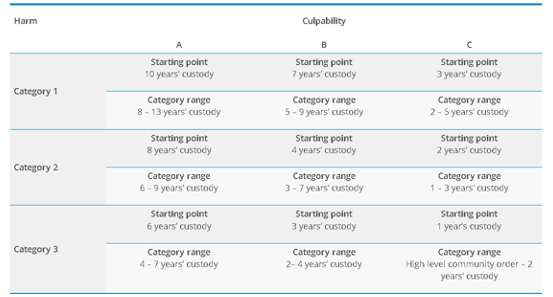
10. Collecting of Information
Under section 58 of the Terrorism Act 2000, a person commits an offence if they:
- Collect or make a record of information of a kind likely to be useful to a person committing or preparing an act of terrorism (includes downloading); or
- Possess a document or record containing information of that kind; or
- View, or otherwise access, by means of the internet a document or record containing information of that kind.
For the purposes of section 58, a record included a photographic or electronic record.
The person’s culpability is defined into one of following categories (A = highest, C= lowest):
Category A
- Offender collected, made a record of, was in possession of, or viewed or otherwise accessed over the internet, information for use in a specific terrorist act
Category B
- Offender collected, made a record of, was in possession of, or viewed or otherwise accessed over the internet, information likely to be useful to a person committing or preparing an act of terrorism and the offender had terrorist connections or motivations
Category C
- Offender collected, made a record of, was in possession of, or viewed or otherwise accessed over the internet, information likely to be useful to a person committing or preparing an act of terrorism but had no terrorist connections or motivations
The person’s harm caused is defined into one of following categories (1= highest, 3 = lowest):
Category 1
- Material provides instruction for specific terrorist activity endangering life and harm is very likely to be caused
Category 2
- Material provides instruction for specific terrorist activity endangering life but harm is not very likely to be caused
- Material provides instruction for specific terrorist activity intended to cause widespread or serious damage to property, or economic interest or substantial impact upon civic infrastructure
Category 3
- All other cases
Collection of information for terrorist purposes is a triable either way offence and if found guilty a person could receive a sentence which ranges from high level community order to 15 years imprisonment depending on the person’s culpability.
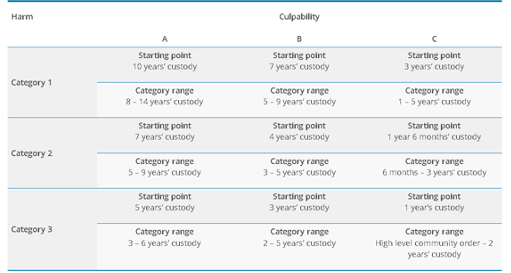
Serious Terrorism Sentence of Imprisonment
Section 282A of the Sentencing Act 2020, specifies that a serious terrorism of imprisonment is a sentence of imprisonment the term of which is equal to the aggregate of:
- The appropriate custodial term; and
- A further period (the extension persiod0 for which the offender is to be subjected to a licence.
Section 282B of the Sentencing Act 2020, specifies the circumstances which are required for a serious terrorism sentence of imprisonment can be imposed. The circumstances are:
- The offence was committed on or after the day on which section 5 of the Counter-Terrorism and Sentencing Act 2021 came into force;
- The offender was aged 18 or over when the offence was committed;
- The offender is aged 21 or over when convicted of the offence;
- The court is of the opinion that there is a significant risk to members of the public of serious harm occasioned by the commission by the offender of further serious terrorism offences or other specified offences (see section 308);
- The court does not impose a sentence of imprisonment for life; and
- The risk of multiple deaths condition is met.
The Court must impose a serious terrorism sentence of imprisonment under section 282A, unless the court is of the opinion that there are exceptional circumstances which:
- Relate to the offender; and
- Justify not doing so
The risk of multiple deaths condition is that the court is of the opinion that:
- Either
- The serious terrorism offence; or
- The combination of the offence and one of more offences associated with it was very likely to result in or contribute to (whether directly or indirectly) the deaths of at least two people as a result of an act of terrorism (within the meaning of section 1 of the Terrorism Act 2000) and;
- The offender was, or ought to have been, aware of that likelihood
It is irrelevant for the purposes of determining whether the risk of multiple deaths condition is met whether or not any death actually occurred.
Where an offence is found to have been committed over a period of 2 or more days, or at some time during a period of 2 or more days, it must be taken for the purposes of subsection (1) to have been committed on the last of those days.
Section 282C of the Sentencing Act 2020, applies where the court is dealing with an offender and is required by section 282B to impose a serious terrorism sentence of imprisonment under section 282A.
The appropriate custodial term is:
- 14 years; or
- If longer, the term of imprisonment that would be imposed in respect of the offence in compliance with section 231(2) (length of discretionary custodial sentences) if the court did not impose a serious terrorism sentence of imprisonment (or an extended sentence or a sentence under section 278)
The extension period must be a period of length that the court consider necessary for the purpose of protecting members of the public from serious harm occasioned by the commission by the offender of further serious terrorism offences or other offences.
The extension period must be at least 7 years but not exceed 25 years.
Terrorism Legislation
The Terrorism Act 2000
The Terrorism Act 2000 defines terrorism, both in and outside of the UK.
The definition of terrorism is "the use or threat of one or more of the actions listed below, and where they are designed to influence the government, or an international governmental organisation or to intimidate the public. The use or threat must also be for the purpose of advancing a political, religious, racial or ideological cause."
The Anti-Terrorism, Crime and Security Act 2001
The Anti-Terrorism, Crime and Security Act 2001 ensure the good severity of dangerous substances that may be targeted or used by terrorists.
The Prevention of Terrorism Act 2005
The Prevention of Terrorism Act 2005 is an act that provides for individuals involved in terrorism-related activity. The purpose of the act is to prevent or restrict these individuals in further involvement in such activity.
The Terrorism Act 2006
The Terrorism Act 2006 reforms and extends provisions in previous counter-terrorism legislation (e.g. the Intelligence Act 1994 and the Regulation of Inventory Powers Act 2000) and includes new offences to ensure that UK law enforcement agencies have the necessary powers to counter the threat to the UK posed by terrorism.
The Counter-Terrorism Act 2008
The Counter-Terrorism Act 2008 makes further provisions about the detention and questioning of terrorist suspects and the prosecution and punishment of terrorist offences.
The Counter-Terrorism and Boarder Security Act 2019
The Counter-Terrorism and Border Security Act 2019 updates existing counter-terrorism legislation to ensure that it is fit for the digital age and reflect contemporary patterns of radicalisation.
The Counter-Terrorism and Sentencing Act 2021
The Counter-Terrorism and Sentencing Act (2021) ends the prospect of early release for anyone convicted of a serious terror offence and forces them to spend their whole term in jail. The most dangerous offenders - such as those found guilty of preparing or carrying out acts of terrorism where lives were lost or at risk - now face a minimum of 14 years in prison and up to 25 years on licence, with stricter supervision.



